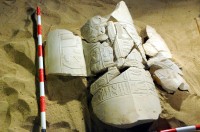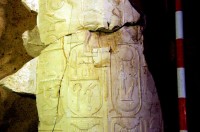 There has long been a debate among historians and Egyptologists over whether Amenhotep III and his son, the future Akhenaten shared a co-regency towards the end of the father’s reign, with some experts positing a power sharing arrangement lasting as long as 12 years or as short as two years. Much of the recent scholarship on the controversy has argued against the co-regency theory altogether. There has been no solid archaeological evidence to resolve the debate, but on Thursday Dr. Mohammed Ibrahim, Egypt’s Minister of Antiquities, announced that inscriptions found in the Luxor tomb of Vizier Amenhotep-Huy provide conclusive evidence that Amenhotep III shared power with Akhenaten for at least eight years in the waning days of the elder’s reign.
There has long been a debate among historians and Egyptologists over whether Amenhotep III and his son, the future Akhenaten shared a co-regency towards the end of the father’s reign, with some experts positing a power sharing arrangement lasting as long as 12 years or as short as two years. Much of the recent scholarship on the controversy has argued against the co-regency theory altogether. There has been no solid archaeological evidence to resolve the debate, but on Thursday Dr. Mohammed Ibrahim, Egypt’s Minister of Antiquities, announced that inscriptions found in the Luxor tomb of Vizier Amenhotep-Huy provide conclusive evidence that Amenhotep III shared power with Akhenaten for at least eight years in the waning days of the elder’s reign.
The inscriptions were carved onto architectural remains, collapsed walls and columns, in tomb number 28 in the El Asasif area of Luxor. Some of the inscriptions depict scenes of father and son together in the same space as one follows the other. There are also cartouches — the prenomen or throne name of a pharaoh surrounded by a protective oval — of both pharaohs next to each other. Traditionally, viziers’ tombs always bear the cartouche of the pharaoh they served under.
As if that weren’t bonanza enough, the inscriptions date to a very specific time: the first Heb-Sed of Amenhotep III. The Heb-Sed was a feast like a royal jubilee celebrated by a pharaoh 30 years into his reign and then every three years after that. Since Amenhotep ruled for approximately 38 years (1388–1351 B.C. or 1391–1353 B.C.). Records survive referring to his 38th regnal year and some historians believe he may have begun his 39th but died very soon into it. That means father and son were co-regents for at least eight years.
 Amenhotep III has the most surviving statues of any pharaoh, 250 of them from the beginning of his reign all the way through to the end. The ones towards the end depict an ailing man. Forensic examination of his mummy found evidence of arthritis, obesity and a plethora of dental caries and abscesses which must have been excruciatingly painful. He was in his 50s at the time of his death, so it makes sense that after ruling over Egypt since he was a boy, he enlisted his son to help him when his myriad illnesses made the business of pharaohing increasingly difficult.
Amenhotep III has the most surviving statues of any pharaoh, 250 of them from the beginning of his reign all the way through to the end. The ones towards the end depict an ailing man. Forensic examination of his mummy found evidence of arthritis, obesity and a plethora of dental caries and abscesses which must have been excruciatingly painful. He was in his 50s at the time of his death, so it makes sense that after ruling over Egypt since he was a boy, he enlisted his son to help him when his myriad illnesses made the business of pharaohing increasingly difficult.
The vizier’s tomb was first unearthed in 1978. A multi-national team led by the Instituto de Estudios del Antiguo Egipto de Madrid have been excavating, recording and studying the architectural elements of the tomb since 2009. You can read more about on the website of the Vizier Amenhotep-Huy Project. It’s in Spanish, but if you can’t read it in the original it’s worth it to use an online translator to explore the excavation diaries for each season. There are some great videos of the digs too.
The self-effacing Dr Hawass is no longer Antiquities Minister?
Heh heh… He was fired in 2011 after the removal of Mubarak. This article lays the history out nicely.
This is not true. No new evidence has been found for any coregency. It’s all hot air by inept ‘egyptologists’ picked up by an Egyptian official.
What makes you say that? Do you have special information as to the competence of the Instituto de Estudios del Antiguo Egipto de Madrid team? They’ve been working for four seasons. Has it all been inept? I can see both cartouches in the photograph. Was that image doctored, in your opinion, or is there some other explanation for it?
I didn’t say they doctor or falsify things but are well-connected inept people. How would you describe people who say in a video that natron is a mixture of calcium salts or that this vizier was a ‘saint’ and that’s why many later burials are there, when it is very common to find later burials in earlier tombs from people who just couldn’t afford otherwise? Martin Valentin long ago published an Egyptian Grammar in Spanish for which he was accused to plagiarize other works and was full of errors, accusations he never could answer satisfactorily… Caveat emptor, also in archaeology.
Thanks for the Hawass link. Drama queen to the end! Being named “explorer-in-residence” by the aggressively and shamelessly commercial National Geographic Society is hardly the Nobel Prize.
Amen to that.
To Julio: Julio: You don’t have any right to slander me to me or my team. Because you us difames will not change the fact of our discovery.
Disqualify us is not the way to discuss scientifically the results of an investigation.
Who you are in truth July? Why are you so full of rage and hatred?.
Best regards
Francisco Martín Valentín
Instituo de Estudios del Antiguo Egipto
The problem is that the team from “Instituo de Estudios del Antiguo Egipto” in each publication speaks about, that the work was completed on the tomb by year 30 of A III. and the memory of Amenhotep Huy was pursued. He should be so disgraced?
Unfortunately, nowhere explains the team how it comes to this date (year 30). What features in the tomb in concrete allow such a conclusion? Furthermore, it is completely ignored that Amenhotep Huy is securely attested in office in year 35 of A III. (Gebel El Silsila stele).
Thus makes a persecution of his memory and discontinuation of work on his tomb before year 35, in my view, little sense?
What evidence does the Antiquities Dept now claim to have, given the skepticism about the dating of A-Huy’s burial?
Its no surprise that he was buried at Luxor; most ‘Amarna’ people were buried in that general area too. He was evidently very active in year 35 of A-III and probably well beyond that time, even possibly working briefly under King Tut. So its no surprise to find a pair of royal cartouches featuring A-III and IV together. It does not prove a co-regency.